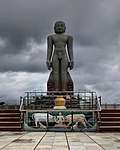Chandraprabha
In Jainism, Chandraprabha was the eighth Tirthankara of Avasarpini (present half cycle of time as per Jain cosmology). Chandraprabhu was born to King Mahasena and Queen Lakshmana Devi at Chandrapuri to the Ikshvaku dynasty. According to Jain texts, his birth-date was the twelfth day of the Posh Krishna month of the Indian calendar. He is said to have become a siddha, i.e. soul at its purest form or a liberated soul.
| Chandraprabha | |
|---|---|
8th Jain Tirthankara | |
 Chandraprabha statue at Chandragiri Vatika, Tijara | |
| Other names | Chanda Prabhu |
| Venerated in | Jainism |
| Predecessor | Suparshvanatha |
| Successor | Pushpadanta |
| Symbol | Crescent Moon |
| Height | 150 bows (450 meters) |
| Age | 1,000,000 purva (70.56 Quintillion years) |
| Color | White |
| Personal information | |
| Born | |
| Died | |
| Parents |
|
| Part of a series on |
| Jainism |
|---|
 |
|
Jain prayers |
|
Ethics |
|
Major sects |
|
Texts |
|
Festivals
|
|
|
Jain biography
Life before renunciation
Chandraprabha was the eighth Jain Tīrthankara of the present age (avasarpini).[1] He was born to King Mahasena and Queen Lakshmana Devi at Chandrapuri, Varanasi on 12th day month Pausa in the Ikshvaku clan.[1][2][3] Nine months before the birth of Chandraprabha, Queen Lakshmana Devi dreamt the sixteen most auspicious dreams.[4] Chandraprabha spent 2 lakh pūrva as youth (kumāra kāla) and ruled His kingdom for 6 lakh pūrva and 24 pūrvāṇga (rājya kāla). During his rule, Chandraprabhu was apathetic towards the ordinary delights and princely grandeur.[5][6]
Renunciation
His life to renounced his worldly life, soon after his ascension to throne and after 3 months he obtained Kevala Jnana (omniscience) while mediating under Naga tree.[2] After a many years of spreading his knowledge, he is said to have attained nirvana at Sammed Shikharji on the seventh day of the bright half of the month of Bhadradha.[5][4]
Disciples
According to Jain texts Vaidarbha Svami was the leader of the Chandraprabha disciples.[6]
Adoration
Svayambhūstotra by Acharya Samantabhadra is the adoration of twenty-four Tīrthankaras. Its five slokas (aphorisms) are dedicated to Tīrthankara Chandraprabha.[7]
With complexation bright5 as the rays of the moon you had the radiated knowledge like another moon. You are worshiped by eminent beings; you are the Lord of learned ascetic; and had conquered all your karmas and internal passion. I bow to you, O Lord Chandraprabha, the processor of moonlike splendour.
— Svayambhūstotra (8-1-36)[8]
Chandraprabha is associated with crescent moon emblem, Naga tree, Vijya or Syama (Dig.) & Vijya (Svet.) Yaksha and Jwalamalini (Dig.) & Bhrikuti (Svet.) Yakshi.[9][2][10]
Iconography
Chandraprabha is usually depicted in a lotus or kayotsarga posture, with a crescent moon symbol beneath him;[2] each tīrthankara has a distinct emblem, which allows worshippers to distinguish similar idols.[11] Like all tirthankaras, he is depicted with a Shrivatsa[note 1] and downcast eyes.[14]
The earliest known sculpture of Chandraprabha was installed by Maharajadhiraja Ramagupta of Gupta dynasty. Chandraprabha has been popular amongst Jain everywhere in India. The iconography of Chandraprabha is particularly popular in Eastern India in Bihar, Bengal and Orissa. Sculptures of Chandraprabha were also popular in Jain temples, Deogarh, Khajuraho Jain temples and Sonagiri.[15]
 Idol at Jain temple, Lakkundi
Idol at Jain temple, Lakkundi- Idol at Saavira Kambada Basadi
 The famous idol of Chandraprabhu at Tijara
The famous idol of Chandraprabhu at Tijara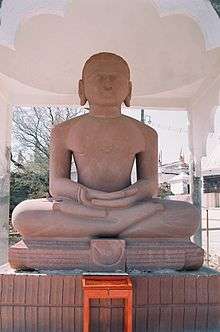 Chandraprabhu Bhagwan, Sonagiri Ji
Chandraprabhu Bhagwan, Sonagiri Ji Chandraprabhu idol at (Patnaganj, Rehli, M.P)
Chandraprabhu idol at (Patnaganj, Rehli, M.P) Chandraprabha temple inside Jaisalmer Fort
Chandraprabha temple inside Jaisalmer Fort
- Colossal statue
Main temples
- Sonagiri
- Tijara Jain Temple
- Saavira Kambada Basadi in Moodabidri
- Jainimedu Jain temple
- Chandravati
- Kumbakonam Jain Temple
- Prabhas Patan
- Lunwa Jain temple
- Saavira Kambada Basadi (The 1000 Pillars Temple) also known as "Chandranatha Temple"
- Chandraprabhu Jain Temple inside the Jaisalmer fort
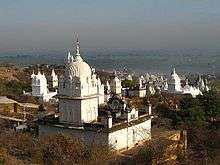 Sonagiri Jain Tirth
Sonagiri Jain Tirth Sonagiri Jain temple
Sonagiri Jain temple Tijara Jain temple, Tijara, Rajasthan
Tijara Jain temple, Tijara, Rajasthan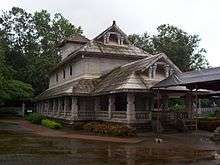
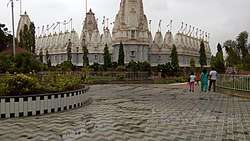
See also
| Wikimedia Commons has media related to Chandraprabha. |
- Arihant (Jainism)
- God in Jainism
- Jainism and non-creationism
- Tijara Jain Temple
Notes
- A special symbol that marks the chest of a Tirthankara. The yoga pose is very common in Buddhism, Hinduism, and Jainism. Each tradition has had a distinctive auspicious chest mark that allows devotees to identify a meditating statue to symbolic icon for their theology. There are several srivasta found in ancient and medieval Jain art works, and these are not found on Buddhist or Hindu art works.[12][13]
References
Citation
- Tukol 1980, p. 31.
- Shah 1987, p. 142.
- Time of India & 4 Tirthankaras born in Varanasi.
- Jain 2015, p. 189.
- Jain 2009, p. 78.
- Jain 2015, p. 190.
- Jain 2015, p. 44-50.
- Jain 2015, p. 52.
- Titze 1998, p. 5.
- Tandon 2002.
- Zimmer 1953, p. 225.
- von Glasenapp 1925, pp. 426–428.
- Jainism: Jinas and Other Deities Archived 26 May 2017 at the Wayback Machine, Victoria and Albert Museum, London
- Melton & Baumann 2010, p. 1553.
- Shah 1987, pp. 142-144.
Sources
- Johnson, Helen M. (1931), Candraprabhacaritra (Book 3.6 of the Trishashti Shalaka Purusha Caritra), Baroda Oriental Institute
- Tukol, T. K. (1980). Compendium of Jainism. Dharwad: University of Karnataka.
- Tandon, Om Prakash (2002) [1968], Jaina Shrines in India (1 ed.), New Delhi: Publications Division, Ministry of Information and Broadcasting, Government of India, ISBN 81-230-1013-3
- Shah, Umakant Premanand (1987), Jaina-rūpa-maṇḍana: Jaina iconography, Abhinav Publications, ISBN 978-81-7017-208-6
- Jain, Arun Kumar (2009), Faith & Philosophy of Jainism, Gyan Publishing House, ISBN 9788178357232, retrieved 23 September 2017
- Jain, Vijay K. (2015), Acarya Samantabhadra’s Svayambhustotra: Adoration of The Twenty-four Tirthankara, Vikalp Printers, ISBN 9788190363976
- Titze, Kurt (1998). Jainism: A Pictorial Guide to the Religion of Non-Violence. Motilal Banarsidass. ISBN 978-81-208-1534-6.
- Zimmer, Heinrich (1953) [April 1952], Campbell, Joseph (ed.), Philosophies Of India, London, E.C. 4: Routledge & Kegan Paul Ltd, ISBN 978-81-208-0739-6CS1 maint: location (link)
- von Glasenapp, Helmuth (1925), Jainism: An Indian Religion of Salvation, Delhi: Motilal Banarsidass (Reprinted 1999), ISBN 978-81-208-1376-2
- Melton, J. Gordon; Baumann, Martin, eds. (2010), Religions of the World: A Comprehensive Encyclopedia of Beliefs and Practices, One: A-B (Second ed.), ABC-CLIO, ISBN 978-1-59884-204-3
